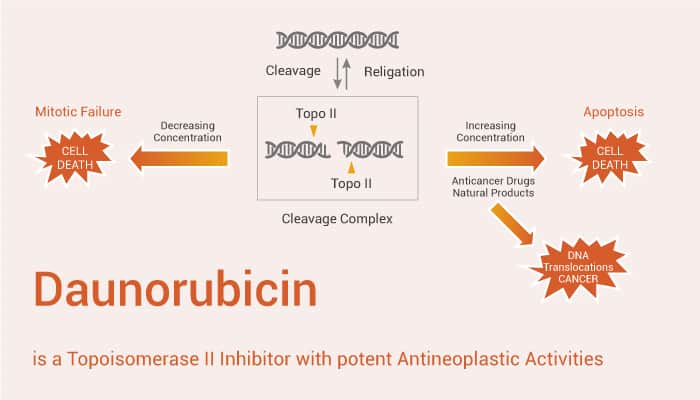Topoisomerases are enzymes that regulate the overwinding or underwinding of DNA. The winding problem of DNA arises due to the intertwined nature of its double-helical structure. Topoisomerases are isomerase enzymes that act on the topology of DNA. Type I topoisomerase cuts one strand of a DNA double helix, relaxation occurs, and then the cut strand is reannealed. Type II topoisomerase cuts both strands of one DNA double helix, pass another unbroken DNA helix through it, and then reanneal the cut strands. Topoisomerase II (Top II) is an important host factor for host DNA replication. However, since the accumulation of DNA double-stranded breaks (DSBs) causes cell cycle arrest, cell death, or apoptosis through the DNA damage response, both the expression level and the catalytic activity of Top II are regulated during the cell cycle.

Daunorubicin (also known as Daunomycin) is a topoisomerase II (Top II) inhibitor with a wide spectrum of activity against malignancies. In addition, Daunorubicin inhibits Top II-mediated re-ligation of transient DSBs in DNA and finally accumulate damaged DNA. Thus, this compound causes DNA damage responses through the activation of the ATM/Chk2 signaling pathway, and finally through G2/M cell cycle arrest in normal cells. Moreover, Daunorubicin also causes DNA damage-dependent IFN-β induction through exogenous cGAS and subsequently suppresses Ebola virus (RNA virus) replication. Besides, Daunorubicin inhibits cell proliferation through the DNA damage response in immortalized human hepatocytes NKNT-3/NTCP cells, but does not cause cell death. Daunorubicin prevents viral production rather than viral DNA replication against HBV by inducing a cGAS-dependent innate immune response.
To sum up, Daunorubicin is a topoisomerase II inhibitor with a wide spectrum of anticancer activity and anti-HBV effect.
References:
[1] Hirotaka Imai, et al. Biochem Biophys Res Commun. 2018 Oct 12;504(4):672-678.